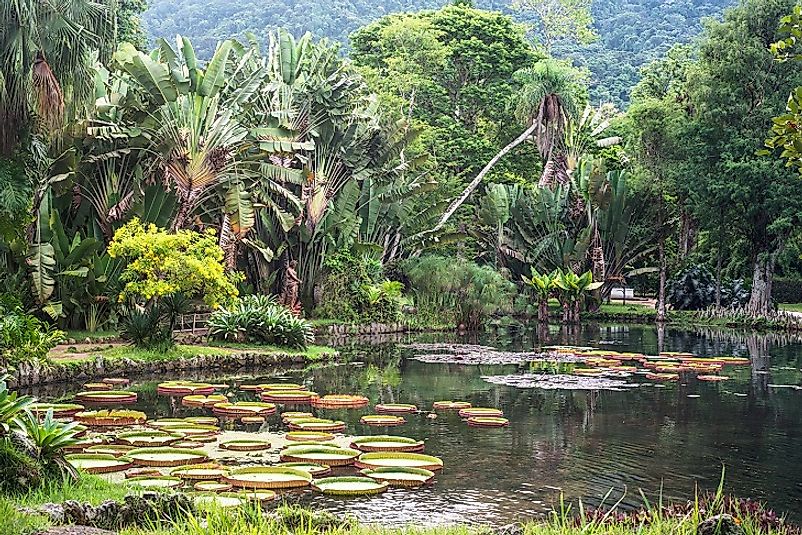Habitats And Ecosystems Of Brazil

Brazil is the largest country in South America, covering an area of 3,287,597 square miles. It shares a 4,655-mile coastline with the Atlantic Ocean and borders the majority of the countries in the continent. Divided into several ecological regions, Brazil is rich in natural resources and wildlife. In fact, Brazil is one of the world’s 17 mega-diverse countries. This article takes a look at the various ecosystems within the country.
Terrestrial Ecosystems of Brazil
Terrestrial ecosystems exist only on land and include several types of habitats. In Brazil, these habitats include tropical and subtropical moist broadleaf forests, tropical and subtropical dry broadleaf forests, tropical and subtropical grasslands, savannas, and shrublands, flooded grasslands and savannas, desert and xeric shrublands, and mangroves.
The tropical and subtropical moist broadleaf forests are also referred to as the rainforest (due to their high levels of rainfall) in Brazil. This ecosystem is home to 1 in 10 identified species on earth. Approximately 427 mammal species, 1,300 bird species, 378 reptiles, and over 400 amphibians live here.
The tropical dry forests typically experience a water loss throughout the year with very little rainfall. This ecosystem is located around the edges of the rainforest and provides shelter for several endangered species including the broad-snouted caiman, giant armadillo, and maned wolf.
The tropical grassland and shrubland regions of Brazil have some trees that have adapted their bark to resist the natural fires which sometimes ignite in the area. This ecosystem is home to over 150 amphibian species, 120 reptile species, 837 bird species, and 161 mammal species.
The Bahia mangrove forest covers an area of 800 square miles in northeastern Brazil. It includes red, black, and white mangrove trees, the roots of which provide protection to several keystone predator species.
Brazilian Freshwaters
Freshwater ecosystems include lakes, ponds, rivers, and wetlands. Brazil has 9 different freshwater ecoregions. The largest and most well-known of these is the Amazon river system, delta, and its tributaries. Its tributaries are surrounded by forests that become flooded during every rainy season. The river itself is home to several endangered animals, including such aquatic mammals as the Amazon river dolphin, tucuxi dolphin, and Amazon manatee. Fish are abundant as well, such as the piranha, arapaima, and electric eel. Researchers discover approximately 50 new species every year.
Offshore Biodiversity
The tropical Atlantic marine ecosystem includes the North Brazil Shelf and the Tropical Southwestern Atlantic habitats. The North Brazil Shelf covers an area of approximately 424,712 square miles and contains .01% of the world’s coral reef systems, yet the majority of the species are endemic. The Amazon river empties into this area, providing a significant quantity of nutrients to the sea vegetation.
The warm, temperate southwestern Atlantic marine ecosystem is located off of the heavily populated and urbanized southeastern coast of Brazil. This area is home to large populations of tuna, dolphins, and several whale species.
Threats to Brazil's Environment
Each of the above mentioned ecosystems is fragile, and at risk of becoming imbalanced. While large tracts of land are protected as natural reserves and parks in Brazil, many more areas are left to be developed and stripped of their natural resources. Agricultural production is a big threat to many of these areas, particularly the grasslands and forests. In order to create space for crops to feed livestock and humans, forests must be removed which completely changes the landscape and habitat for native animals.
Savannas and grasslands are also damaged due to the charcoal production which is utilized by the country’s steel industry. As these areas are being deforested, people take advantage of the exposed tree trunks and roots to create charcoal. Selling the charcoal provides them with extra money to continue deforestation and to buy seeds for crops.
The mangrove forests and saltwater marine ecosystems are severely threatened by the urban sprawl which infringes upon the natural areas. By cutting down trees and covering green spaces with cement to create space for apartments, parking garages, and shopping centers, wildlife are displaced. These urban areas also produce pollution that is washed away into the surrounding sea. This contamination has degraded the water quality and killed off many of the local fish, reptile, and marine mammal species. What hasn’t been killed by contamination is being exploited for human consumption. The entire coastline of Brazil is filled with tuna and shrimp fisheries that have over exploited and depleted the populations.
The government, private groups, and non-governmental organizations (NGOs) need to take stands against these destructive practices. Creating public educational strategies and restrictive policies is one way to control this environmental degradation. Without action, Brazil will soon lose all of its natural resources and rich biodiversity.
Habitats And Ecosystems Of Brazil
| Ecosystems of Brazil | Type |
|---|---|
| Tropical and Subtropical Moist Broadleaf Forests | Terrestrial |
| Tropical and Subtropical Dry Broadleaf Forests | Terrestrial |
| Tropical and Subtropical Grasslands, Savannas, and Shrublands | Terrestrial |
| Flooded Grasslands and Savannas | Terrestrial |
| Deserts and Xeric Shrublands | Terrestrial |
| Mangroves | Terrestrial |
| Jacui Highlands-Lagoa dos Patos Coastal Plain Complex | Freshwater |
| Pantanal-Lower Parana Complex | Freshwater |
| Llanos de Moxos-Beni Savanna | Freshwater |
| Alto Parana Atlantic | Freshwater |
| Sao Francisco-Caatinga-Cerrado Complex | Freshwater |
| Mata Atlantica | Freshwater |
| Maranhao | Freshwater |
| Amazon River System, Delta, and Tributaries | Freshwater |
| Orinoco River System-Guiana Watershed | Freshwater |
| North Brazil Shelf | Tropical Atlantic Marine |
| Tropical Southwestern Atlantic | Tropical Atlantic Marine |
| Warm Temperate Southwestern Atlantic | Temperate South American Marine |











